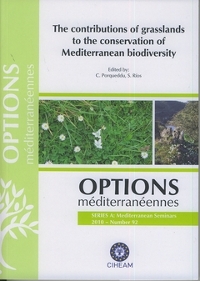| Article précédent | p. 205-208 | Article suivant |
An assessment of short-term cattle grazing effects on honeybee forage potential in Mediterranean rangelands
Beekeepers in Israel claim that cattle grazing during spring reduces honey production potential as a result of the removal of flowers. We studied the impacts of cattle grazing on honeybee forage during spring in a semi-arid Mediterranean habitat. Cattle was introduced to fenced plots in order to reach the required stoking rates and measurements of floral abundance and honeybee visits were carried out during five surveys. In this study, the impact of cattle grazing on honeybee forage activity appeared to be related to floral abundance and to the blooming periods of specific plant species rather than species richness. Crucifers and woody perennials, mainly Labiatae, seemed to be more attractive to honeybees than most herbaceous annuals. Overall, intensive grazing during the spring flowering season did not seem to suppress the full bloom potential or restrain flower production within local flora. Grazing at moderate to high levels (i.e. 0.4-0.8 cows/ha) may actually support natural honeybee forage by increasing the abundance of some important plant species. However it is recommended to restrict certain areas from grazing to support key species that are restrained by grazing and crucial for honeybee forage at the end of the season.
Ce travail a pour objet l'étude de l'impact du pâturage des bovins sur le potentiel de butinage des abeilles en Israël où les apiculteurs pensent que le broutage des fleurs par les bovins en réduit l'abondance. Nous avons introduit des bovins dans des terrains clôturés afin d'atteindre les taux de chargement requis, puis nous avons mesuré l'abondance florale et les passages d'abeilles au cours de cinq relevés. L'impact du pâturage sur l'activité des abeilles semble être lié à l'abondance florale et aux périodes de floraison plutôt qu'à la richesse des espèces. Des crucifères et des plantes vivaces ligneuses, principalement des labiées, semblent attirer davantage les abeilles que la plupart des herbacées annuelles. D'une manière générale, le pâturage intensif au printemps, pendant la saison de floraison, n'a pas semblé supprimer le potentiel de pleine floraison ou faire décliner la production de fleurs de la flore locale. Le pâturage à des niveaux modérés à élevés (c.-à-d. 0.4 à 0.8 vaches/ha) pourrait en fait encourager le butinage naturel des abeilles en augmentant l'abondance de certaines espèces de plantes importantes, mais il est aussi recommandé d'exclure du pâturage certaines zones afin d'encourager d'autres espèces clé que le pâturage fait décliner et qui pourraient jouer un rôle important dans le butinage des abeilles en fin de saison.
- [ Afficher ]
- [ Télécharger ]
- [ Exporter la citation ]
Vous pouvez télécharger la citation au format :
- [ Imprimer ]
-
Mots-clés
APIDAE, BOVIN, FLORE, INTENSITE DE PATURAGE, ISRAEL, PATURAGE, RECHERCHE DE NOURRITURE, REGION MEDITERRANEENNE, ZONE SEMI-ARIDECiter cet article
Kaminer A., Kigel J., Dag A., Henkin Z. An assessment of short-term cattle grazing effects on honeybee forage potential in Mediterranean rangelands. In : Porqueddu C. (ed.), Ríos S. (ed.). The contributions of grasslands to the conservation of Mediterranean biodiversity. Zaragoza : CIHEAM / CIBIO / FAO / SEEP, 2010. p. 205-208. (Options Méditerranéennes : Série A. Séminaires Méditerranéens; n. 92). 13. Meeting of the Sub-Network on Mediterranean Forage Resources of the FAO-CIHEAM International Network for the Research and Development of Pasture and Forage Crops, 2010/04/07-10, Alicante (Spain). http://om.ciheam.org/om/pdf/a92/00801243.pdf



